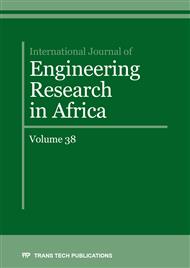p.1
p.9
p.17
p.26
p.46
p.60
p.67
p.79
p.87
Experimental Study of Temperature Effect on Drilling Mud with Local Additives
Abstract:
Drilling mud is an essential component in well drilling processes. The high temperature at the bottom of wells tend to reduce the mud viscosity and density, thereby affects the ability of the mud to perform its useful purpose in the drilling operation. Additives are usually added to the mud to enhance its properties to meet desired specifications. Carboxylmethyl Cellulose (CMC) is added to increase the mud viscosity and barite is added to increase the mud density. This work presents an investigation on possible substitutes for these additives. Locally sourced materials, Cassava (Manihot manifera) and Water yam (Dioscoria alata) were compared to barite and CMC. The properties measured are the rheological properties of the mud slurry which are plastic viscosity, apparent viscosity, yield point and gel strength, mud density, filtration properties at varying high temperatures (120 – 150 oF), and hydrogen-ion (pH value). The results revealed that both local additives can serve as weighting materials as they increased mud density more than barite. Filtration properties of water yam were better than CMC and Fresh mud both at room temperature and high temperatures. The results futher indicated that water yam and cassava additives were non acidic, therefore are less corrosive as compared to CMC which was acidic. It was concluded that cassava and water yam are potential substitutes of CMC.
Info:
Periodical:
Pages:
9-16
Citation:
Online since:
September 2018
Keywords:
Price:
Сopyright:
© 2018 Trans Tech Publications Ltd. All Rights Reserved
Share:
Citation:


